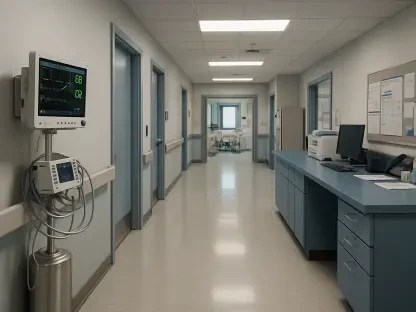The healthcare sector in the United States finds itself in a precarious position, grappling with an unprecedented surge of cyberattacks that jeopardize patient safety and privacy on a daily basis, while ransomware and data breaches have become alarmingly common, disrupting critical care and exposing sensitive medical records to malicious actors. The fallout from these incidents—delayed treatments, overburdened facilities, and eroded trust—paints a grim picture of an industry under siege. Aimee Cardwell, a respected voice in cybersecurity, argues that waiting for government-led solutions is a luxury healthcare cannot afford. Instead, immediate action from within the industry is essential to safeguard data and ensure uninterrupted care. This pressing issue demands exploration into why delays in addressing cybersecurity are untenable and what steps must be taken now to protect millions of patients. The stakes are high, and the time for hesitation has long passed, as every day without robust defenses puts lives and livelihoods at risk.
Escalating Cyber Threats in Healthcare
The rapid escalation of cyber threats targeting healthcare organizations has reached a critical level, with millions of patients bearing the brunt of these attacks. High-profile breaches, such as the Episource incident impacting 5 million records and the ransomware assault on Maryland’s Frederick Health affecting over 900,000 records, underscore the sheer magnitude of the crisis. These incidents are not mere data leaks; they disrupt essential medical services, leading to postponed surgeries and overwhelmed emergency rooms. The ripple effects extend beyond immediate operational chaos, as patients lose confidence in the systems meant to protect them. Hackers exploit the healthcare sector’s vulnerabilities with increasing sophistication, knowing that the value of medical data on the black market is immense. This relentless wave of attacks serves as a stark reminder that the industry must prioritize defense mechanisms to shield both data and the well-being of those who depend on timely care.
Beyond the numbers, the human toll of these cyber incidents reveals a deeper tragedy unfolding within healthcare systems. Each breach translates into real-world consequences—patients unable to access life-saving treatments, families grappling with the fallout of exposed personal information, and providers scrambling to restore normalcy. The emotional and financial burden often falls on individuals already navigating complex medical challenges. Moreover, the frequency of such attacks shows no sign of abating, with cybercriminals capitalizing on the sector’s often outdated technology to gain unauthorized access. This pattern of exploitation highlights a critical gap in preparedness that cannot be ignored. As threats grow more advanced, the urgency to fortify defenses becomes paramount, ensuring that patient care remains uninterrupted and trust in healthcare institutions is preserved against the backdrop of an ever-evolving digital battleground.
Structural Flaws Exacerbating Risks
At the core of healthcare’s cybersecurity crisis lies a web of structural flaws that render systems dangerously susceptible to attacks. Many organizations still rely on legacy technology, with outdated software and hardware unable to withstand modern threats. Fragmented data storage further compounds the issue, as large enterprises often manage dozens of unintegrated Electronic Health Record (EHR) systems. This disjointed setup creates blind spots, where even basic tasks like tracking patient data become nearly impossible. Without clear visibility into where sensitive information resides, responding to breaches or ensuring compliance with regulations like HIPAA turns into a logistical nightmare. These systemic weaknesses are not just technical oversights; they represent a fundamental failure to adapt infrastructure to the realities of today’s cyber landscape, leaving patient information perilously exposed to exploitation.
Compounding these technical shortcomings is the organizational fragmentation that plagues much of the healthcare sector. Siloed teams—often split between security, privacy, and engineering—lack the coordination needed to mount a unified defense against cyber threats. This disconnect is particularly evident in the wake of frequent acquisitions, where newly merged entities operate on disparate systems with little integration. The result is a patchwork of vulnerabilities that hackers can easily target. Additionally, the absence of standardized protocols for data management across departments hinders proactive risk mitigation. Addressing these structural issues requires more than just technological upgrades; it demands a cultural shift toward collaboration and accountability. Only by dismantling these internal barriers can healthcare organizations hope to build a resilient framework capable of safeguarding data against the relentless pace of cybercrime.
Slow Federal Response Amid Urgent Needs
Legislative efforts to bolster healthcare cybersecurity, such as the proposed Healthcare Cybersecurity Act, offer a glimmer of hope through planned collaboration between federal agencies like the Department of Health and Human Services and the Cybersecurity and Infrastructure Security Agency. However, the pace of these initiatives falls far short of the urgency required. Past attempts to enact similar legislation in 2022 and 2024 failed to gain traction, and current proposals include timelines—such as reports due in 120 days—that feel disconnected from the daily risks faced by providers. Patients whose personal data is compromised cannot afford to wait months or years for policy to translate into tangible protections. This sluggish response from federal bodies underscores a critical disconnect between the immediacy of cyber threats and the slow machinery of government action, leaving the industry in a precarious position.
The limitations of federal intervention extend beyond mere timing to the practical challenges of implementation. Even if new laws are passed, the process of translating broad mandates into actionable, on-the-ground strategies often encounters bureaucratic hurdles and inconsistent enforcement. Healthcare organizations, already stretched thin by operational demands, may struggle to adapt to evolving guidelines without sufficient resources or clarity. Meanwhile, cybercriminals operate with no such constraints, exploiting delays to launch increasingly sophisticated attacks. This disparity highlights the inadequacy of relying solely on external solutions to address an internal crisis. The gap between legislative intent and real-world impact serves as a potent reminder that while federal support is valuable, it cannot be the sole pillar of defense in a sector where every second counts for patient safety and data security.
Shifting Focus to Internal Reforms
A pivotal argument in addressing healthcare cybersecurity lies in the need for internal reforms rather than dependence on external mandates. Industry leaders must reframe cybersecurity as an integral component of patient care, not merely a compliance checkbox or occasional expense. This shift in mindset calls for substantial investments in modern data infrastructure that can eliminate vulnerabilities inherent in outdated systems. Equally critical is the alignment of security, privacy, and engineering teams to create a cohesive front against threats. By fostering collaboration across these often siloed departments, organizations can enhance visibility into data flows and respond more effectively to incidents. Such internal accountability empowers healthcare providers to tackle risks at their source, offering a faster and more tailored approach than waiting for broad legislative fixes.
Implementing these reforms requires a commitment to both resources and cultural change within healthcare entities. Modernizing systems with automated, integrated solutions can streamline data management and reduce the likelihood of breaches stemming from human error or oversight. Beyond technology, cultivating a shared understanding that cybersecurity directly impacts patient outcomes is essential. This perspective ensures that budgets and priorities reflect the gravity of the issue, rather than treating it as a secondary concern. Despite the significant revenue generated by the sector, recent surveys indicate that a troubling percentage of cybersecurity professionals report no dedicated funding for these protections. Closing this gap demands decisive action from leadership to allocate resources where they are most needed, reinforcing the notion that internal initiative is the cornerstone of sustainable defense in an era of relentless cyber threats.
Consequences of Delaying Action
The repercussions of inaction on cybersecurity in healthcare are profound, affecting both organizations and the patients they serve. For providers, data breaches trigger a cascade of challenges, including costly lawsuits, substantial revenue losses, and severe reputational damage that can take years to repair. These financial and public relations burdens often divert resources away from core missions like patient care. Meanwhile, patients face even graver consequences—privacy violations that expose their most sensitive information, delays in critical treatments, and declining health outcomes as a direct result of disrupted services. The weight of these impacts falls heaviest on vulnerable populations who rely on timely and secure medical support, amplifying the urgency to address cybersecurity as a fundamental priority rather than an afterthought.
Beyond immediate effects, the long-term fallout from neglecting cybersecurity erodes the very foundation of trust in healthcare systems. Public confidence diminishes with each reported breach, creating a vicious cycle where patients hesitate to share vital information, further complicating care delivery. Additionally, the operational costs of managing breaches—often passed on to consumers through higher fees—place an added strain on an already burdened system. Alarmingly, despite the industry’s trillion-dollar revenue, recent findings show that a significant portion of cybersecurity professionals lack specific budgets for protective measures. This disconnect between financial capacity and allocation reveals a critical misstep in prioritization. The broader implications for industry stability and patient welfare underscore that delays in fortifying defenses carry a price too steep to ignore, demanding swift and resolute action from within.
Building a Resilient Future Through Action
Reflecting on the past, the healthcare sector struggled with an escalating cybersecurity crisis that exposed deep vulnerabilities in infrastructure and organizational priorities. The surge in ransomware and data breaches disrupted countless lives, while systemic flaws and slow federal responses left gaps that cybercriminals eagerly exploited. These challenges painted a sobering picture of an industry at a crossroads, where the cost of inaction was measured in compromised care and lost trust. Yet, amidst these struggles, a clear path emerged through the advocacy of experts like Aimee Cardwell, who emphasized internal accountability over external dependency. The lessons from these past shortcomings remain a powerful catalyst for change, urging a reevaluation of how cybersecurity intertwines with the mission of healing.
Looking ahead, healthcare leaders must commit to actionable strategies that fortify defenses without delay. Modernizing infrastructure with integrated, automated systems stands as a critical step to eliminate blind spots and enhance data protection. Equally vital is fostering a culture where cybersecurity is inseparable from patient care, ensuring that resources and focus align with this priority. Collaboration across teams can further strengthen resilience, breaking down silos to create a unified response to threats. The industry cannot afford to wait for external solutions when patients need protection today. By embracing these practical measures, healthcare can build a future where trust is restored, and safety is assured, proving that proactive steps taken now will shape a more secure tomorrow for all stakeholders involved.









